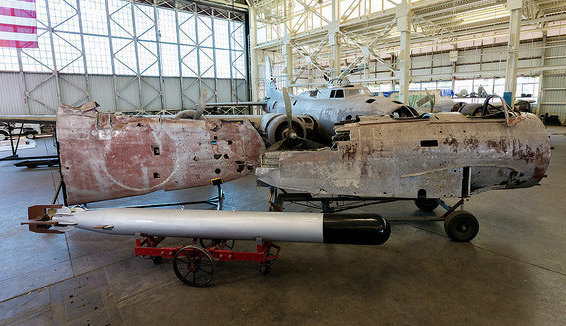There were three different types of Japanese aircrafts that rained down bombs on Pearl Harbor in the early morning of December 7, 1941. The Nakajima B5N bomber was the most destructive of the group, and quickly became one of the most feared and deadly weapons used during World War II.
United States allied forces nicknamed it “Kate.” There were 1,149 B5N bombers that circulated during this war. However, today there are only two that have even partially survived, and zero intact Kates remain.
Later this year will mark the 75th anniversary of the infamous Pearl Harbor attack. Hawaii’s Pacific Aviation Museum Pearl Harbor has added the wreckage of one of the most infamous Kates to its permanent collection.
Kenneth DeHoff, the museum’s executive director of operations, told the Huffington Post, “This [bomber] is truly a one-of-a-kind. You can see the rising sun red ball [from the Japanese flag] on the wing; the paint is still there.”
Though many Nakajima B5Ns were used to attack Pearl Harbor, this particular one was not involved in the attack. It was built the following year, in 1942, according to DeHoff. The Kate can already be seen on public display (next to the much-revered “Swamp Ghost”), and the museum is putting forth efforts to bring it back to life. A restoration process that will cost approximately $1 million is projected to take place over five years. Upon completion, it will be the only restored Kate in the entire world.
DeHoff claims the restoration will be very complete and thorough and will even enable it to be cranked up for flying.
The museum has been tight-lipped about how it acquired the plane in the first place. However, they guarantee that it was got through legal channels. (In the past, governments such as Papua New Guinea have accused salvagers of illegally removing planes from their countries.)
Pacific Wrecks is a nonprofit site directed by Justin Taylan. He studied and documented the entire history of the bomber by delving into the records of its assigned identification number, 302. Based on his research he thinks the plane flew its final flight in 1945. It was at Rabaul, which was a Japanese stronghold at the tip of New Britain Island in Papua New Guinea.
Taylan was also able to research when the plane was acquired. It appears the Pacific Aviation Museum added the plane to its collection sometime after 2010. The museum’s annual reports from 2011 and 2012 show the plane was stored in New Zealand.
While there is no way to completely confirm when or how this particular bomber was acquired, the museum will not confirm or deny Taylan’s theory. This restoration process will provide an important and unique piece to the World War II puzzle, especially as regards Pearl Harbor.
The Pacific Aviation Museum is located on Ford Island, which is right in the middle of Pearl Harbor. It will be pretty amazing to see this aircraft stand in the exact same spot where it once caused so much damage. DeHoff describes it as a once-in-a-lifetime experience, one that gives you a real sense of being there.
